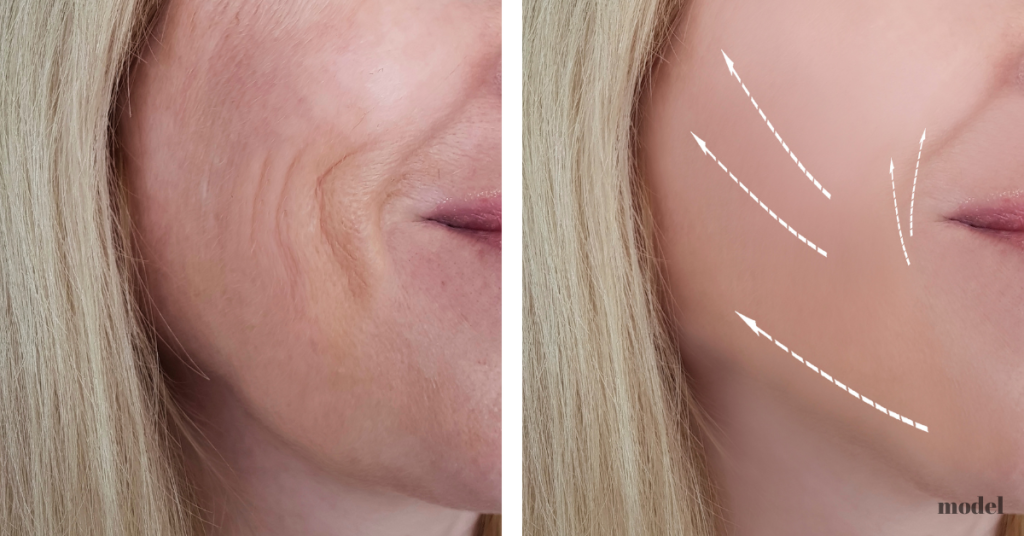As the number of dermal filler options continues to expand, knowing how long you can expect the results of injections to last gets more complicated. Long gone are the days of workhorse fillers that were used to address concerns in most areas of the face. Now, TEOSYAL®, JUVÉDERM®, and Restylane® all offer specialized hyaluronic acid-based fillers—not to mention non-HA fillers that may last longer.
Why Are Fillers So Popular?
According to statistics from The Aesthetic Society, more than 1.8 million dermal filler treatments were performed in 2021. It’s a safe bet that the number will continue to increase year after year since dermal fillers address a universal concern—facial aging.
As we age, our faces gradually lose volume due to a loss of both fat and bone density. This creates an aged, slack appearance. Dermal fillers are an extremely effective tool for restoring that youthful volume. Treatments are relatively brief, there is little to no downtime, and the cost of fillers is much less than the price of cosmetic surgery. The results are temporary, though, and maintaining the outcomes requires periodic appointments.
In addition to turning back the clock, fillers are also popular with younger patients who want to reshape certain facial features, such as the nose, cheeks, or lips.
What Can Dermal Fillers Treat?
Dermal fillers can achieve a wide variety of rejuvenation and contouring goals. They can:
- Plump thin lips
- Enhance shallow contours
- Soften facial creases and wrinkles
- Improve the appearance of recessed scars
- Reconstruct contour deformities in the face
- Decrease or remove shadow on the lower lids
- Change the shape of the nose
How long these changes last depend on the specific fillers that are used. You can also combine fillers with prescription wrinkle injections for a nonsurgical facelift.
Different Types of Fillers
The most common injectable fillers are made with a substance called hyaluronic acid, a molecule that’s naturally present in the body. In fillers, hyaluronic acid is modified with chemical “cross linkages” that extend the life of the products. The HA molecule is ideal for restoring volume because it attracts water. Other fillers use different active ingredients than hyaluronic acid.
- Hyaluronic acid is the primary ingredient of TEOSYAL, Restylane, Restylane Lyft (formerly known as Perlane-L®), JUVÉDERM, and JUVÉDERM VOLUMA, a few commonly used dermal fillers. The smooth gel fillers vary in consistency, with thicker fillers typically injected deeper than thin fillers. These fillers can be dissolved with hyaluronidase if needed.
- RADIESSE® is a gel composed of microspheres containing calcium hydroxylapatite (CaHA), which is biocompatible. It’s approved by the FDA to improve moderate to severe facial wrinkles and folds, such as nasolabial folds. In addition to immediate results seen after injections, RADIESSE stimulates the growth of connective tissue in and around the microspheres to prolong the results.
- Sculptra® is another non-HA filler that stimulates the production of new collagen after being injected. Its main ingredient is poly-L-lactic acid (PLLA), and it gradually restores volume. It’s primarily used to improve the appearance of sunken cheeks and can last for 2 years or more.
What’s important to understand about fillers such as RADIESSE and Sculptra is that, unlike hyaluronic acid-based fillers, the results cannot be reversed if a patient isn’t happy with the outcome.
Filler Longevity
| Dermal filler | How long does it last? |
| JUVÉDERM VOLUMA | About 24 months with a touch-up treatment at 12 months to help with longevity |
| JUVÉDERM Ultra and Ultra Plus | About 12 months, with a possible touch-up at 6–9 months |
| JUVÉDERM VOLLURE | Approximately 12–18 months |
| JUVÉDERM VOLBELLA | Approximately 12 months |
| Restylane Defyne, Refyne, and Lyft | About 12 months, with a possible touch-up at 6–9 months |
| Restylane Silk | Approximately 6–10 months. |
| Restylane-L | Approximately 5–7 months. |
| RADIESSE | Approximately 15 months |
| Sculptra | Can last more than 24 months |
What Can Affect a Filler’s Longevity?
In addition to the type of filler, other factors can influence how long the results of filler treatments last. These factors include:
- The areas of the face or body being treated
- How much of the filler is used
- How fast a patient’s body metabolizes the filler
Fillers begin degrading within a few months of the treatment, but the visible results persist because the fillers absorb water and expand. At a certain point, though, you’ll begin to notice decreasing volume in the treatment area. Touch-up injections at this point are beneficial because they can sustain the results for much longer using less filler than was used in the initial treatment.
You can learn more about your filler and other cosmetic injectable options, including BOTOX®, by requesting a consultation online or calling our Mississauga office at (905) 273-3045 or our Toronto office at (416) 207-9090.


Leave a Reply